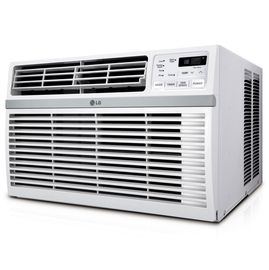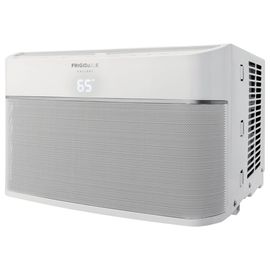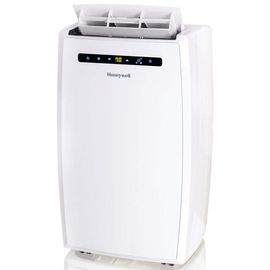LG LW8016ER Review
Est. Price: $279
Buy it from Home Depot, Walmart, and AJ Madison
There's no need to sweat it out in hot weather, even if you're on a budget. There are plenty of highly rated air conditioners around $300 or less that can cool a room to a comfortable level and keep it that way. To help choose the best air conditioners, we considered test results and professional feedback from Consumer Reports, Wirecutter, and Top Ten Reviews, among others. However, some manufacturers release new models every year (with relatively minor updates), so often there is not a lot of expert input on current models. To see how newer units fare, we scoured hundreds of consumer reviews on manufacturer and retailer sites, including Amazon, Home Depot, Lowe's, Walmart, Best Buy, and Target.
These user and expert reviews pointed us to models with 5,000 BTUs to 10,000 BTUs of cooling power from respected brands like Frigidaire, GE, and LG. All are easy to set up, and many offer a range of popular features, such as a remote controls, thermostats, and timers. We fleshed out our list of favorites with two Wi-Fi-enabled “smart” ACs, a model that can be used in a window or as a through-the-wall unit, and a portable air conditioner for convenient cooling in any room.
Note: Air conditioners from the same manufacturer often differ slightly in model number and features depending on the retailer. Be sure to check the specs carefully before buying one of these alternatives. Also, most cheap air conditioners are designed for double-hung windows; options are limited with casement or slider windows.
Prices and availability are subject to change.

Est. Price: $279
Buy it from Home Depot, Walmart, and AJ Madison

Est. Price: $279
Buy it from Home Depot, Walmart, and AJ Madison
Best Overall Value
Pros:
Cons:
Takeaway: The LG LW8016ER has been kicking around for a few years, but it continues to claim strong support from users for overall performance and manages to take the top spot on Wirecutter's 2019 list of best air conditioners. With this cool customer, once a room arrives at the desired comfort level — a state quickly reached — reviewers say it stays that way. For the price, the feature set on this affordable LG AC is fairly generous, and it includes a dehumidify function that users appreciate, as well as a few less-common extras that reviewers at Wirecutter suggest may prove equally valuable (like a drain plug in the back for removing excess condensation). About the only issue with this highly praised air conditioner is the noise. Some reviewers consider it fairly loud even as others assert that this model is the quietest ever. For those willing to pay a bit more for the very latest edition, the LW8018ER, prices start around $350. This upgrade boasts 8,200 BTUs and even greater efficiency, with an impressive 12.5 combined energy efficiency ratio (CEER).

Est. Price: $136
Buy it on Home Depot and Walmart
Best Cheap Air Conditioner
Pros:
Cons:
Takeaway: The Frigidaire FFRA051WAE/WA1 is the newer version of the Frigidaire FFRA0511R1E, a simple budget model popular with experts and consumers alike. Prized for its relatively diminutive size (16" W x 12" H x 15.3" D), this compact air conditioner is particularly well-suited for homes with tiny windows — a notable advantage cited by owners of the previous model. Consumers say the AC cools smaller bedrooms, studios, workshops, and even a few RVs in a matter of minutes — and keeps them cool — without making too much of a racket. Of course, the mechanical controls are a bit “old school,” and you won't find features like a remote control, timer, energy-saver mode, or clean-filter alert here. But given the low cost, few buyers seem to mind. User reviews pertaining to this exact model (which sells as the FFRA051WAE at some retailers and the FFRA051WA1 at others) are limited, but those we found are quite positive overall — not surprising, as changes from the earlier model are quite minimal and should only improve functionality. This Frigidaire air conditioner sports a bit tiny bit more amperage and a more eco-friendly and efficient refrigerant than its predecessor.

Best Small Air Conditioner
Pros:
Cons:
Takeaway: This particular line of LG air conditioners continues to earn solid marks from reviewers, and one version or another appears on most lists of the best air conditioners. Affordable, capable, and relatively quiet cooling are the hallmark of these consumer favorites, and the particularly high energy efficiency of the most recent models places them at the top of the heap when compared with the competition. The LG LW6019ER actually exceeds Energy Star requirements, besting standards for efficiency by 12.73% as opposed to the mandated 10%. While the lack of owner reviews for this new model would normally keep us from offering a wholehearted endorsement, what we saw of its performance in testing by Consumer Reports suggests that an unequivocal thumbs-up is well merited. Skeptical shoppers who would prefer a model with a proven track record might consider the LG LW6017R ($219 at Home Depot ). This older, cheaper 6,000 BTU LG air conditioner is still quite popular and has many of the same features, but you'll sacrifice the Energy Star rating and some of the cooling power in the swap.
Best 10,000-BTU Air Conditioner
Pros:
Cons:
Takeaway: It’s not the most recent model, but the Frigidaire FFRE1033U1 stands out for delivering the same high level of performance as its predecessors in a line of Frigidaire ACs that are longtime top sellers. Its close cousin, the 8,000 BTU Frigidaire FFRE8033U1, is recommended by testers at Wirecutter as a runner-up choice for best air conditioner of 2019, and reviews for this larger model are similarly positive. It’s loaded with the features most users want, for a comparatively reasonable price. Owners report that this Frigidaire air conditioner is easy to operate and install and cools large rooms, or even multiple rooms, in a flash. An optional ionizer gives the filter a boost by actively pulling contaminants from the air, which may be a boon to allergy sufferers (although some doubt the claimed benefits of this technology). The very latest 10,000-BTU models from Frigidaire include the FFRE103WAE/WA1 and the FFRE103ZA1, but these tend to be harder to find. There are also few reviews and too many small differences between models to confidently assess their relative merits. Prudent shoppers will most likely prefer to go with the tried-and-true FFRE1033U1.

Est. Price: $270
Buy it on Walmart, Best Buy, Home Depot, Lowe's, and AJ Madison
Best Value Smart Air Conditioner
Pros:
Cons:
Takeaway: Like many reviewers, we're not necessarily convinced that Wi-Fi connectivity is entirely worth the extra cost when it comes to air conditioners, but the comparatively low price of the LG LW8017ERSM certainly makes it an attractive choice. It's widely popular with experts and has earned Top Ten Reviews' endorsement as the all-around best air conditioner of 2019. With the same base features and specifications as our best value pick, the LG LW8016ER, the smart LW8017ERSM earns points for its admirable ability to keep rooms comfortable on top of giving tech geeks a thrill. Users claim it can even cool well beyond the 340 square feet suggested. While some complain that the app is not entirely up to snuff, and setup could certainly be less cumbersome, others appreciate the intuitive interface. Regardless, the customized control that Wi-Fi connectivity offers (even if it's not perfect) is a nice addition to an already attractive package — especially when this smart AC can sometimes be found for less than its "unconnected" LG cousin.

Est. Price: $350
Buy it from Best Buy and AJ Madison
More Stylish Smart Air Conditioner
Pros:
Cons:
Takeaway: Users say it’s hard to resist the stylish, svelte appeal of a Wi-Fi-enabled Frigidaire Gallery air conditioner. Look on virtually any list of recommended smart air conditioners and you’re bound to find the “Cool Connect” making an appearance, usually toward the top. Although experts and users report that connectivity may be hit or miss (which is true for smart ACs in general), and some say the app feels dated, it’s generally agreed that the ability to program this AC from afar to ensure a return to a pre-cooled home can make warm-weather days so much more tolerable. The Frigidaire FGRC084WA1/WAE is the very latest model in the line, and while user reviews for this version are sparse, what we’ve seen suggests that it delivers similar, if not improved, performance compared with its predecessor. (This model uses a more efficient refrigerant, and it’s got about half an amp and 5 more watts of power than the Frigidaire FGRC0844U1.)

Est. Price: $339
Buy it from Walmart and Home Depot
Best Cheap Portable Air Conditioner
Pros:
Cons:
Takeaway: Portable air conditioners are an option for buyers who have windows (or landlords) that won't allow a window air conditioner, worry about installation headaches, or want the option of using a single unit across multiple rooms as needed. Convenience, affordability, and a user-friendly design are the greatest strengths of the Honeywell MN10CES, along with its chilling chops. Setting up this Honeywell portable air conditioner (which comes with a window venting kit and hose) is a breeze, reviewers say, and doesn’t deter them from moving the unit into and out of rooms or storage. Users also report that large rooms cool down without a struggle. But, buyer be warned: In general, portable air conditioners tend to be less energy efficient than window air conditioners. They also draw criticism for being underpowered — in fact, new government testing procedures for these types of units suggest maximum BTU levels that are much lower than previous ratings. So it may not be wise to trust coverage area estimates, and sizing up may be necessary.

Est. Price: $426
Buy it on AJ Madison
Bonus — Wall Air Conditioner
Pros:
Cons:
Takeaway: This Friedrich air conditioner can be mounted in a window or installed through the wall if necessary — an option that’s attractive for homeowners looking to limit light blockage or cool a room that may not have any windows. Effective performance and quiet operation are hallmarks of the Friedrich brand, and comparative testing done by product review site Your Best Digs bears that out. Pitted against two top-rated Frigidaire and LG air conditioners, the Friedrich Chill CP08G10B proved very consistent in its cooling, adjusting quickly to temperature swings. It was also by far the most “chill” when it came to noise level. In user reviews many boast that it’s among the quietest ACs they’ve ever had, and it’s frequently recommended for use in bedrooms. It’s true that this Friedrich AC costs a bit more than typical competitors, but for a through-the-wall air conditioner, the price is not unreasonable, and many purchasers say the build quality is a step above the rest.